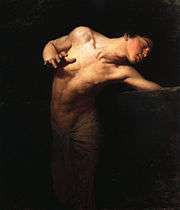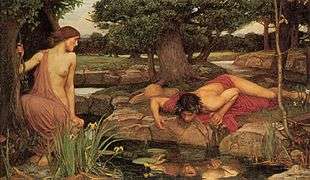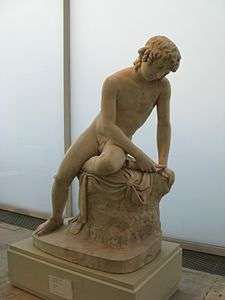Narcissus (mythology)
_edited.jpg)
In Greek mythology, Narcissus (/nɑːrˈsɪsəs/; Greek: Νάρκισσος, Nárkissos) was a hunter from Thespiae in Boeotia who was known for his beauty. He was the son of the river god Cephissus and nymph Liriope.[1] He was proud, in that he disdained those who loved him. Nemesis noticed this behavior and attracted Narcissus to a pool, where he saw his own reflection in the water and fell in love with it, not realizing it was merely an image. Unable to leave the beauty of his reflection, Narcissus lost his will to live. He stared at his reflection until he died. Narcissus is the origin of the term narcissism, a fixation with oneself and one's physical appearance.
Etymology
The name is of uncertain etymology. According to R. S. P. Beekes, "[t]he suffix [-ισσος] clearly points to a Pre-Greek word."[2] The word narcissus has come to be used for the daffodil, but there is no clarity on whether the flower is named for the myth, or the myth for the flower, or if there is any true connection at all. Pliny the Elder wrote that the plant was named for its fragrance (ναρκάω narkao, "I grow numb") not the youth.
Ancient sources
Several versions of the myth have survived from ancient sources. The classic version is by Ovid, found in book 3 of his Metamorphoses (completed 8 AD); this is the story of Echo and Narcissus. One day Narcissus was walking in the woods when Echo, an Oread (mountain nymph) saw him, fell deeply in love, and followed him. Narcissus sensed he was being followed and shouted "Who's there?". Echo repeated "Who's there?". She eventually revealed her identity and attempted to embrace him. He stepped away and told her to leave him alone. She was heartbroken and spent the rest of her life in lonely glens until nothing but an echo sound remained of her. Nemesis (as an aspect of Aphrodite[3]), the goddess of revenge, learned of this story and decided to punish Narcissus. She lured him to a pool where he saw his own reflection. He didn't realize it was only an image and fell in love with it. He eventually recognized that his love could not be reciprocated and committed suicide.[4]
An earlier version ascribed to the poet Parthenius of Nicaea, composed around 50 BC, was recently rediscovered among the Oxyrhynchus papyri at Oxford.[5] Like Ovid's version, it ends with Narcissus committing suicide. A version by Conon, a contemporary of Ovid, also ends in suicide (Narrations, 24). In it, a young man named Ameinias fell in love with Narcissus, who had already spurned his male suitors. Narcissus also spurned him and gave him a sword. Ameinias committed suicide at Narcissus's doorstep. He had prayed to the gods to give Narcissus a lesson for all the pain he provoked. Narcissus walked by a pool of water and decided to drink some. He saw his reflection, became entranced by it, and killed himself because he could not have his object of desire.[4] A century later the travel writer Pausanias recorded a novel variant of the story, in which Narcissus falls in love with his twin sister rather than himself (Guide to Greece, 9.31.7).[6]
Psychology
In 1898 Havelock Ellis, an English sexologist, used the term "narcissus-like" in reference to excessive masturbation, whereby the person becomes his or her own sex object.[7]
In 1899, Paul Näche was the first person to use the term "narcissism" in a study of sexual perversions.
Otto Rank, in 1911, published the first psychoanalytical paper specifically concerned with narcissism, linking it to vanity and self-admiration.[7]
Sigmund Freud only published a paper exclusively devoted to narcissism in 1914, called "On Narcissism: An Introduction".[8]
One of the personality disorders is called narcissistic personality disorder.
Influence on culture
Тhe myth of Narcissus has inspired artists for at least two thousand years, even before the Roman poet Ovid featured a version in book III of his Metamorphoses. This was followed in more recent centuries by other poets (e.g. Keats and Alfred Edward Housman) and painters (Caravaggio, Poussin, Turner, Dalí (see Metamorphosis of Narcissus), and Waterhouse).
Literature
.jpg)

In Stendhal's novel Le Rouge et le Noir (1830), there is a classic narcissist in the character of Mathilde. Says Prince Korasoff to Julien Sorel, the protagonist, with respect to his beloved girl:
She looks at herself instead of looking at you, and so doesn't know you.During the two or three little outbursts of passion she has allowed herself in your favor, she has, by a great effort of imagination, seen in you the hero of her dreams, and not yourself as you really are.
(Page 401, 1953 Penguin Edition, trans. Margaret R.B. Shaw).
The myth had a decided influence on English Victorian homoerotic culture, via André Gide's study of the myth, Le Traité du Narcisse ('The Treatise of the Narcissus', 1891), and the only novel by Oscar Wilde, The Picture of Dorian Gray.
Paulo Coelho's The Alchemist also starts with a story about Narcissus, found (we are told) by the alchemist in a book brought by someone in the caravan. The alchemist's (and Coelho's) source was very probably Hesketh Pearson's The Life of Oscar Wilde (1946) in which this story is recorded (Penguin edition, p. 217) as one of Wilde's inspired inventions. This version of the Narcissus story is based on Wilde's "The Disciple" from his "Poems in Prose (Wilde) ".
Author and poet Rainer Maria Rilke visits the character and symbolism of Narcissus in several of his poems.
Seamus Heaney references Narcissus in his poem "Personal Helicon"[9] from his first collection "Death of a Naturalist":
"To stare, big-eyed Narcissus, into some spring
Is beneath all adult dignity."
In Rick Riordan's Heroes of Olympus series, Narcissus appears as a minor antagonist in the third book The Mark of Athena.
In the fantasy series Harry Potter, Narcissa Malfoy, a minor antagonist, is named for Narcissus.
William Faulkner's character "Narcissa" in Sanctuary, sister of Horace Benbow, was also named after Narcissus. Throughout the novel, she allows the arrogant, pompous pressures of high-class society to overrule the unconditional love that she should have for her brother.
Hermann Hesse's character "Narcissus" in "Narcissus and Goldmund" shares several of mythical Narcissus' traits, although his narcissism is based on his intellect rather than his physical beauty.
A. E. Housman refers to the 'Greek Lad', Narcissus, in his poem Look not in my Eyes from A Shropshire Lad set to music by several English composers including George Butterworth. At the end of the poem stands a jonquil, a variety of daffodil, Narcissus Jonquilla, which like Narcissus looks sadly down into the water.
Herman Melville references the myth of Narcissus in his novel Moby-Dick, in which Ishmael explains the myth as "the key to it all," referring to the greater theme of finding the essence of Truth through the physical world.
On Sophia de Mello Breyner Andresen's A Fada Oriana, the eponymous protagonist is punished with mortality for abandoning her duties in order to stare at herself in the surface of a river.
Film
In the TV series Boardwalk Empire, a Dr. Narcisse (Valentin Narcisse) is introduced as a condescending intellectual.
Scottish-Canadian animator Norman McLaren finished his career with a short film named Narcissus, re-telling the Greek legend through ballet.
Narcissus appears in the Disney adaptation of Hercules. In the film, he is portrayed as an Olympian god with purple skin.
In the film Bab'Aziz, directed by Nacer Khemir, a Narcissus like character was portrayed by an ancient prince who sat by a pond for days after days and looked at the reflection of his own soul. He was referred to as 'The prince who contemplated his soul'.
Pink Narcissus is an artistic film by James Bidgood about the fantasies of a hustler.
The escape craft Ripley boards in the 1979 Ridley Scott film Alien is called the Narcissus.
In the 2011 film Seeing Heaven, Narcissus is depicted in a painting - the character of the film also replicates the myth of Narcissus gazing at his own reflection. The film delves deeply into the main character (Paul) and the theme is loosely based on the myth of Narcissus, as all who look at Paul are transfixed by his beauty - just as all those who gazed upon Narcissus were transifixed with his beauty.
Narcissus is the name of Laurel and Hardy's goat in their 1940 film Saps At Sea.
Music
National Medal Of Arts recipient Morten Lauridsen wrote a choral work entitled "Dirait-on" based on the poem by Rainer Maria Rilke.
"Supper's Ready" by Genesis (ca. 1972), a near-23-minute epic song laden with religious and mythological imagery, refers to the myth of Narcissus as follows: A young figure sits still by the pool / He's been stamped "Human Bacon" by some butchery tool / (He is you) / Social Security took care of this lad. / We watch in reverence, as Narcissus is turned to a flower. / A flower?. The movement is titled "How Dare I Be So Beautiful?".
Progressive metal band Threshold referenced the myth with an 11-minute epic titled "Narcissus", the closing track on their album Hypothetical. Greek metal band Septic Flesh recorded a song about Narcissus (called "Narcissus") on their album Communion.
The cerebral rock band "Glass Wave" retells the Narcissus story from the perspective of the nymph Echo in their song "Echo," from their self-titled album "Glass Wave" (2010).
"Narcissus in a Red Dress" by The Like was released on The Like EP and their album Release Me. The Canadian band Hedley has written a song about Narcissus (called "Narcissist"). One line goes He falls in love with his reflection in the glass / He can't resist who's staring back
Composer Nikolai Tcherepnin wrote his ballet "Narcisse et Echo, Op. 40 in 1911 for Sergei Diaghilev's Ballets Russes and was danced by Nijinski. Uruguayan band El Cuarteto de Nos wrote the song "Me Amo" (I Love Myself) in which the chorus sings "como Narciso soy" (I am like Narcissus). In 2010, Swedish electronic artist pacific! released "Narcissus" an album and ballet staged in Gothenburg.[10] In 1994, composer Mark Applebaum composed Narcissus: Strata/Panacea for marimba solo. This work comprised one movement of the larger Janus Cycle, for mixed instrumentation.[11] In 1987, Thea Musgrave was commissioned by a consortium of four flutists for a solo work. She composed Narcissus for flute and digital delay.[12]
In Marilyn Manson's song Deep Six, One of the lines mentions his name, along with the Greek god Zeus.
As a part of SM Station, Kim Hee-chul, Kim Jungmo (M&D)and Wheein made a song called "Narcissus".[13]
Visual art
Narcissus has been used as a subject by many painters including: Caravaggio, Poussin, Turner, Dalí, Waterhouse, Carpioni, Lagrenée, and Roos.
 Echo And Narcissus, John William Waterhouse
Echo And Narcissus, John William Waterhouse Metamorphosis of Narcissus, Salvador Dalí
Metamorphosis of Narcissus, Salvador Dalí Liriope Bringing Narcissus before Tiresias, Giulio Carpioni
Liriope Bringing Narcissus before Tiresias, Giulio Carpioni Echo and Narcissus, Louis-Jean-François Lagrenée
Echo and Narcissus, Louis-Jean-François Lagrenée Narcissus at the Spring, Jan Roos
Narcissus at the Spring, Jan Roos Narcissus, follower of Giovanni Antonio Boltraffio
Narcissus, follower of Giovanni Antonio Boltraffio
Sculptors such as Paul Dubois, John Gibson, Henri-Léon Gréber and Hubert Netzer have sculpted Narcissus.[14]
 Narcisse, Paul Dubois
Narcisse, Paul Dubois Narcissus, John Gibson
Narcissus, John Gibson Narziss, Hubert Netzer
Narziss, Hubert Netzer- Narcissus, possibly Valerio Cioli
- Narcisse, Henri-Léon Gréber
See also
References
- ↑ "The myth of Narcissus".
- ↑ R. S. P. Beekes, Etymological Dictionary of Greek, Brill, 2009, p. 997.
- ↑ "Aprodite Wrath: Narcissus".
- 1 2 "The myth of Narcissus".
- ↑ David Keys, "Ancient manuscript sheds new light on an enduring myth", BBC History Magazine, Vol. 5 No. 5 (May 2004), p. 9 (accessed April 30, 2010);
- ↑ Mario Jacoby, Individuation and Narcissism (1985; 2006).
- 1 2 Millon, Theodore, Personality Disorders in Modern Life, 2004
- ↑ Freud, Sigmund, On Narcissism: An Introduction, 1914
- ↑ Cf. Ibiblio, Internet Poetry Archive: Text of the Poem Personal Helicon
- ↑ Michael Cragg. "New music: Pacific! - Narcissus". the Guardian.
- ↑ "Narcissus:Strata/Panacea".
- ↑ Theamusgrave.com
- ↑ "Super Junior's Heechul, MAMAMOO's Wheein, and TRAX's Kim Jung Mo Drop "Narcissus" MV".
- ↑ "Paul Dubois, Narcisse, Orsay".
Modern sources
- Graves, Robert (1968). The Greek Myths. London: Cassell.
- Gantz, Timothy (1993). Early Greek Myth. Baltimore: Johns Hopkins University Press.
- Kerenyi, Karl (1959). The Heroes of the Greeks. New York/London: Thames and Hudson.
- Vinge, Louise (1967). The Narcissus Theme in Western Literature up to the Nineteenth Century.
- Calimach, Andrew (2001). Lovers' Legends: The Gay Greek Myths. New Rochelle: Haiduk Press. On-line version
- Alexander, Mark (2012). Narcissus. On-line version.
External links
 Media related to Narcissus (mythology) at Wikimedia Commons
Media related to Narcissus (mythology) at Wikimedia Commons- Papyrology UK